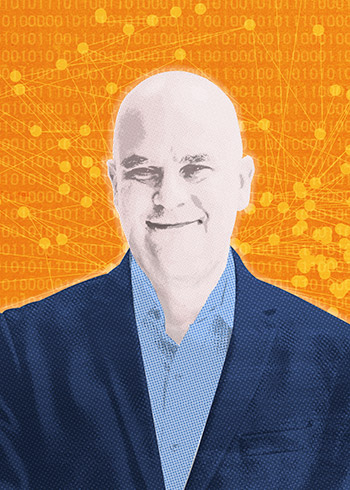Cogent Calculations
Using Algorithms to Address Society’s Challenges

In the modern setting of Illinois Tech’s Medical Imaging Research Center (MIRC), Miles Wernick explains the concept of machine learning—the mathematical approach he is using to analyze violent crime and to diagnose Alzheimer’s disease—not in the language of bits, but in the primary shapes of childhood.
“A young child learns what a square is by being shown little toy shapes. The child looks at them and figures out the differences between shapes in a very complex way that we don’t really understand,” says Wernick, MIRC director and Motorola Endowed Chair Professor of Electrical and Computer Engineering. “Machine learning tries to do the same thing, but our mathematical techniques are nowhere near as sophisticated as whatever the brain is doing. Therefore, computers are not yet as good as people in many tasks; but in certain kinds of tasks, they’re better than people, generally, when the amount of information is too great for our brains to absorb.”
“The algorithms are very accurate. They support the police and help them to steer their activities in a way that is fair, objective, and based on facts.”
- Miles Wernick
That information can take the form of the millions of pixels in medical brain scans. In 2001 Wernick co-founded the startup company Predictek, Inc., in University Technology Park at IIT, to analyze brain scans for pharmaceutical companies, showing how drugs used to treat pain and depression affect the brain. The company has since grown, becoming ADM Diagnostics, LLC, and has shifted its focus to the use of machine learning algorithms to diagnose Alzheimer’s disease, predict further disease progression, and differentiate Alzheimer’s from other forms of dementia, so that drug companies can accurately recruit the appropriate individuals for clinical studies. These algorithms also determine whether a drug is effective during a clinical trial.
Another machine learning project conducted by Wernick and his team has gained national attention for its ability to recognize patterns in massive amounts of crime data. In 2013 he and Yongyi Yang, Harris Perlstein Professor of Electrical Engineering, were awarded $3 million from the National Institute of Justice to partner with the Chicago Police Department (CPD) to institute a new predictive policing program.
As Wernick explains, one algorithm deduces which individuals with recent criminal records are at greatest risk for being involved in a shooting or homicide during the upcoming 18-month period based only on specific involvement in recent crime incidents. These risk evaluations are presented in a webpage at CPD that provides police with the data needed to understand and verify the assessments. Using this information and many other factors, police identify individuals at the very greatest risk for involvement in violence. These individuals are visited at home by a team led by an academic crime intervention specialist, a police commander, and a member of the community, such as a pastor. Visited individuals are warned of the consequences of continued involvement in crime, and intervention support is offered in the form of social services.
“Changing the way an agency does business sounds like a cliché, but Dr. Wernick’s partnership with the Chicago Police Department has led to a new way of looking at crime prediction—from traditional geographic hotspots to identifying risk for a specific subject most likely to be involved in violence,” says Deputy Chief Jonathan H. Lewin of the CPD’s Bureau of Support Services. “This approach has had impact not only in Chicago but in the United States and beyond. Despite the challenges and frustrations, he has remained committed to helping us save lives.”
Wernick’s team has also developed two additional software tools for the CPD. The first predicts the number of violent crimes that will occur daily, and the other maps geographic areas where violent crime is likely to occur. Many law-enforcement agencies across the country have expressed interest in utilizing the team’s algorithms. Wernick will be working with the Elgin (Illinois) Police Department on the project A Data-Driven Crime Prevention Program, as the primary investigator of one of three teams selected to participate in the first phase of Illinois Tech’s Nayar Prize II.
“It’s not done with a crystal ball. It’s experience. The computers are quantitative; they don’t inject any opinions,” explains Wernick. “The algorithms are very accurate. They support the police and help them to steer their activities in a way that is fair, objective, and based on facts.”
More Online
“A New Lab Tool in Alzheimer’s Diagnosis and Treatment”: http://bit.ly/2cp1Qb0
“Image Is Everything”: http://magazine.iit.edu/spring-2010/image-everything